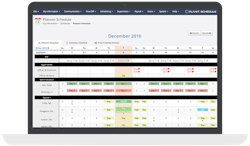The Benefits of New Administrative Management Software
The management of law enforcement personnel and their schedules has come a long way in the last three decades. “It used to be that the operations of managing personnel and their time was a mess,” recalls Dan Ryan, president of Jivasoft, makers of On Duty Scheduling Software. There were pieced-together solutions, he notes, and he recalls some agencies using logbooks that were four-feet high. “They looked like something from the Medieval times,” he jokes. As technology improved, pen and paper gave way to the adoption of spreadsheets for many departments.
With today’s cloud-based solutions, however, there’s an even easier way for departments to post schedules, open shifts, organize and track personnel scheduling tasks. It’s also easier for officers to submit vacation requests and check time off. Today’s administrative management software can give departments a leg up by increasing communication, streamlining tedious tasks and decreasing common personnel errors, ultimately allowing agencies to redeploy resources and get officers back out on the streets.
Administrative management software allows agencies to access information 24/7 on any device—in real time from anywhere. “We live in a world where everyone can access information right away, so why should it be any different with their work schedule?” asks Jon Forknell, Vice President and General Manager at Atlas Business Solutions, Inc., creator of ScheduleAnywhere. Why does increased accessibility matter? It improves communication, he says. Employees can communicate with their managers for time-off requests, and with other employees to swap a shift. “It’s all about visibility and accessibility to information.”
Amy Harcourt, marketing coordinator at PlanIt Schedule, agrees. “The communication throughout police departments will improve … for obvious reasons, like everyone having visibility of the schedule, but also because of tools like Communication Blasts. These allow administrators to contact a whole group of people at once.”
Most agencies build a schedule a year in advance. The advantage of a digital web system is that administrators can see if staffing requirements are being met, whether it’s by a region or skills— something not easily accomplished on a spreadsheet. Usually when departments use spreadsheets, the schedule resides on a wall in a building or on a department computer. When something changes, a new schedule must be printed out, which can cause confusion or a delay in information. Today’s digital web systems let officers get the right information when they need it. “Now when a department posts a schedule, if the schedule changes, whoever made the change can notify just the employees whose schedule was updated,” says Forknell.
Streamline tasks, decrease errors
Not only does this technology improve communication and accessibility to information, it also saves time and decreases the chance for errors. The Rogers, MN, Police Department learned firsthand of time-saving benefits when it invested in ScheduleAnywhere software. Managing time-off requests was a time-consuming task for the department, where requests were submitted on paper and would not be looked at until someone was in the office. In addition to requests being misplaced, they would also take nearly 45 minutes to examine and approve. With the new software, however, requests are submitted and approved online, meaning the department saved hundreds of hours per year.
Administrative management software also provides greater accountability. “Instead of collecting overtime forms through paper or email, they can have officers submit the hours through the system,” says PlanIt Schedule’s Harcourt. “That way, the officer can do it from wherever they are, you have the audit trail of the whole process, the officer will get notified whether approved or denied, and the hours will either go to the payroll export or their comp time bank automatically when approved.”
“We live in a world where everyone can access information right away, so why should it be any different with their work schedule?”
—Jon Forknell, Vice President and General Manager at Atlas Business Solutions, Inc., creator of ScheduleAnywhere
Today’s software also goes beyond scheduling. Chief Douglas Kish of the Catasauqua, PA, Police Department integrated PlanIt Schedule for his 18-person department four years ago when he wanted to move away from a paper system. “I wanted something that was more helpful and user friendly than putting out a spreadsheet every other week,” he says. The software not only allows him to set up the schedule for months in advance, but it also automatically adds employee vacation, adds and deletes their sick time, allows employees to put in overtime and take shifts. “The magistrates even have access to the schedules so they can see if the officer is on vacation so if they go to schedule a hearing in court, they are not conflicting with the officer’s work shift,” he says. “I can also run payroll reports that we send to our treasurer for payroll for the week, too.” Additionally, there is a kiosk feature that runs on a screen in the department’s lunchroom. This allows officers to easily see when they work, and they can request time off right from there. “They can also use the app on their phone,” says Kish.
All of the offerings in administrative management software save time and create efficiencies for departments that influence the job at hand. “It’s completely integrating and automating the process of tracking personnel. If you look at that range of functions, to do them independently is a lot of work. To do it with software, it happens automatically,” says Jivasoft’s Ryan. “The trend of automating administrative tasks means officers can be on the street and out of the police station.”
The challenges
Despite the many benefits, not all agencies in the U.S. are using software to manage personnel. “It’s not that agencies are slow to adopt, but it is just a low priority,” says Forknell. “Even though scheduling is a front-line need, it’s an on-going operating expense and you have to budget for it.” For the cost of the software, with the ROI you can generate, he says, departments can actually save money by reducing unnecessary overtime and spending time on other important duties.
Ryan, however, notes that some agencies may be worried about protecting their data. “When we started out, our program was Windows software at the time. The reactions from people originally were that they didn’t trust their data out there in the world and they were worried that the internet might go down. While people aren’t worried about the internet going down as much these days, they are still worried about protecting their data, as they should be,” says Ryan. But Jivasoft protects its customers’ information. “We do a lot of work to provide a secure environment for our customers’ data. We have firewalls and intrusion detection and other safeguards. We keep up with industry best practices to protect the customers’ data.” His recommendation to agencies is that if you’re working with a software vendor that’s hosting your data, to ensure that the vendor is taking appropriate measures to making sure that information is secure.
Having administrative management software goes beyond scheduling shifts: It becomes a source of intelligence for the agency. “They can run reports and learn about how well their staffing is working,” says Ryan. “Nowadays everything is data driven. Police departments are no different.”
Adrienne Zimmer is a Boise, Idaho-based freelance writer with experience publishing articles in the public safety industry.
Technology to Manage Training
Brian Matuszko, law enforcement specialist at LexisNexis Risk Solutions and former police officer, remembers a time when, as a field training officer, he had to carry around three-ring binders, as big as college textbooks, with information regarding each trainee. Each training officer was responsible for every piece of paper inside of that binder. “The documentation, however, could get lost, get tossed in the back of a vehicle, have coffee stains, get stuffed in lockers and more,” he recalls. And that’s where he saw the problem of dwindling accountability. There was no real true ownership of the training documents. “I wanted a solution where, at the end of the day, the FTO could say they had ownership over their training program so they know exactly what stage those trainees are in at each portion of the program.” Though that used to be done through pen and paper, technological innovation led to Law Enforcement Automated Personnel System (LEAPS). “With LEAPS, we have taken all of the paperwork of a new trainee and consolidated it into a web-based program that is completely configurable,” says Matuszko. “We used to run into miscommunication without this accountability. There was a lack of transparency.” Now, every single training that is required can be captured inside of LEAPS. “A department is always going to know what stage in the training process an individual is at, where they are proficient and where they are lacking so that the agency can say, ‘We’ve done everything we can: This person is good to go or it’s time for them to go.’”
Although this technology used to be considered a ‘nice to have,’ Matuszko says it now has to become a ‘must have.’ “It’s a force multiplier; it helps in so many arenas and it’s one less thing to worry about in the daily task of managing a police department.”

Adrienne Zimmer | Editor
Adrienne Zimmer was the Editor of Law Enforcement Technology magazine, a monthly business-to-business publication that covers technology trends and best practices for public safety managers from 2017 to 2019. LET is part of Officer Media Group, which also publishes Law Enforcement Product News and Officer.com. Adrienne has been in publishing since 2013.




